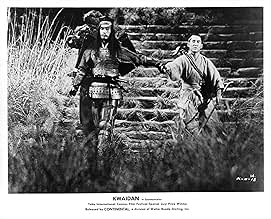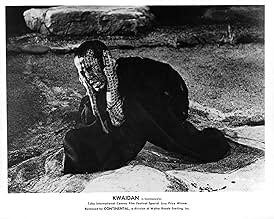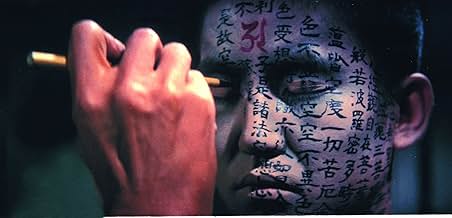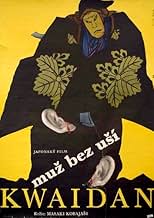CALIFICACIÓN DE IMDb
7.9/10
22 k
TU CALIFICACIÓN
Una colección de cuatro historias tradicionales japonesas con tema sobrenaturales.Una colección de cuatro historias tradicionales japonesas con tema sobrenaturales.Una colección de cuatro historias tradicionales japonesas con tema sobrenaturales.
- Dirección
- Guionistas
- Elenco
- Nominado a 1 premio Óscar
- 5 premios ganados y 2 nominaciones en total
- Dirección
- Guionistas
- Todo el elenco y el equipo
- Producción, taquilla y más en IMDbPro
Opiniones destacadas
Kwaidan is a four-segment horror anthology but you'd be hard pressed to find one more removed from the typical plastic bats and cobwebs Gothic anthologies of Amicus or Hammer. While it can be billed as a "horror" movie and it deals with the supernatural, it's not really frightening. All four segments are more like traditional Japanese folk legends about ghosts, the kind of spooky stories you could hear an elder narrating to kids around a bonfire in a village near Kyoto or the outskirts of Okinawa. However if "work of art" was a genre, Kwaidan would be among the best it had to offer.
Just two years after the seminal Seppuku which was done in stark black and white with a geometric, well disciplined style, Kobayashi returns with another tour-de-force, this time in extravagant, expressionistic colour. A visual feast proving that in the right hands style can be substance. His camera with its slow tracking shots is like a brush, painting a celluloid canvas with vivid, lush compositions and it comes as no surprise to find out that he had a background in painting. The combination of eerie, supernatural material, the dreamlike atmosphere and the use of colour in lighting and sets reminded me of the great Italian maestro, Mario Bava; although Kwaidan by no means fits in the Gothic horror mold.
Conscious of the folk legend material he's working on, Kobaysi wisely shot the movie in studio sets using large painted backgrounds that look deliberately artificial as much as they look gorgeous. In many ways, it feels like a big stageplay or an elaborate dramatic poem. In that aspect, Kwaidan takes place somewhere between the real and the mythic. A land of some other order.
The stories all revolve around ghosts and are as simple and predictable as any spooky story that you might hear as an adult. But they do a great job of providing an eerie skeleton for Kobayashi to hang on his beautiful style. Style over substance one could argue. Isn't that an erroneous statement though? By making the distinction one implies that style is somehow insubstantial to a film, something that couldn't be further from the truth. The use of colour is incredible, the lighting, at times subtle and evocative or wild and expressionistic, the slow tracking shots, long stretches of silence, a body painted with holy text, Tatsuya Nakadai looking calm and happy for a change, Tetsuro Tamba in full plate samurai armor, white ghastly faces, bodies falling in blood-red waters, a painted sunset backdrop, an intelligent play on vague endings, the minimal score, chords echoing from somewhere. Kwaidan proves that style IS substance. A visual feast by all means.
It's really a shame that Kobayashi is not as widely celebrated as Akira Kurosawa. Kwaidan is just another in a series of absolutely brilliant films he did in the 60's. Beautiful, creepy, poetic, atmospheric as hell; it is the work of a master cinematician and one of the best Japanese movies you're likely to see.
Just two years after the seminal Seppuku which was done in stark black and white with a geometric, well disciplined style, Kobayashi returns with another tour-de-force, this time in extravagant, expressionistic colour. A visual feast proving that in the right hands style can be substance. His camera with its slow tracking shots is like a brush, painting a celluloid canvas with vivid, lush compositions and it comes as no surprise to find out that he had a background in painting. The combination of eerie, supernatural material, the dreamlike atmosphere and the use of colour in lighting and sets reminded me of the great Italian maestro, Mario Bava; although Kwaidan by no means fits in the Gothic horror mold.
Conscious of the folk legend material he's working on, Kobaysi wisely shot the movie in studio sets using large painted backgrounds that look deliberately artificial as much as they look gorgeous. In many ways, it feels like a big stageplay or an elaborate dramatic poem. In that aspect, Kwaidan takes place somewhere between the real and the mythic. A land of some other order.
The stories all revolve around ghosts and are as simple and predictable as any spooky story that you might hear as an adult. But they do a great job of providing an eerie skeleton for Kobayashi to hang on his beautiful style. Style over substance one could argue. Isn't that an erroneous statement though? By making the distinction one implies that style is somehow insubstantial to a film, something that couldn't be further from the truth. The use of colour is incredible, the lighting, at times subtle and evocative or wild and expressionistic, the slow tracking shots, long stretches of silence, a body painted with holy text, Tatsuya Nakadai looking calm and happy for a change, Tetsuro Tamba in full plate samurai armor, white ghastly faces, bodies falling in blood-red waters, a painted sunset backdrop, an intelligent play on vague endings, the minimal score, chords echoing from somewhere. Kwaidan proves that style IS substance. A visual feast by all means.
It's really a shame that Kobayashi is not as widely celebrated as Akira Kurosawa. Kwaidan is just another in a series of absolutely brilliant films he did in the 60's. Beautiful, creepy, poetic, atmospheric as hell; it is the work of a master cinematician and one of the best Japanese movies you're likely to see.
Kwaidan is one of the great underappreciated films: no one's heard of it, but you'll never, ever forget it once you've seen it. Parts of it may seem slow to some viewers, and most of the stories are extremely predictable, but I have to say this is one of the most beautiful, haunting movies I've ever seen.
Of all the stories I prefer "Black Hair," the first one. Though a rather pointless horseback archery scene just slows it down, it's by far the scariest and most nightmare-worthy of the stories, using sound to incredibly chilling effect. There's more terror in the last minute of this segment than in all three Scream movies put together. Trust me, if you consider yourself a serious fan of horror cinema, you have to see this.
The second story, "The Woman of the Snow," is good, though I wish it ended more like "Black Hair" (you'll see what I mean). "Hoichi the Earless," with its jaw-dropping sea battle sequence, is by far the biggest and most popular of the stories. It's also the most influential, with its main premise prominently re-used in Conan the Barbarian. The film ends with "In a Cup of Tea." This is the only story that doesn't completely telegraph its ending, and coming after three utterly predictable stories, its complexity is a bit unexpected and disorienting. Certainly it's as creepy and beautiful as the rest of the film, but I have to admit I don't really understand it.
Being a tremendous fan of elegant, understated horror movies, as well as a student of Japanese culture, I consider this film one of my all-time favorites. Granted, some viewers may be turned off by the leisurely pace and the theatrical, intentionally unrealistic sets. But this is undeniably a beautiful and chilling film, absolutely perfect to watch late at night, alone, in the dark.
Of all the stories I prefer "Black Hair," the first one. Though a rather pointless horseback archery scene just slows it down, it's by far the scariest and most nightmare-worthy of the stories, using sound to incredibly chilling effect. There's more terror in the last minute of this segment than in all three Scream movies put together. Trust me, if you consider yourself a serious fan of horror cinema, you have to see this.
The second story, "The Woman of the Snow," is good, though I wish it ended more like "Black Hair" (you'll see what I mean). "Hoichi the Earless," with its jaw-dropping sea battle sequence, is by far the biggest and most popular of the stories. It's also the most influential, with its main premise prominently re-used in Conan the Barbarian. The film ends with "In a Cup of Tea." This is the only story that doesn't completely telegraph its ending, and coming after three utterly predictable stories, its complexity is a bit unexpected and disorienting. Certainly it's as creepy and beautiful as the rest of the film, but I have to admit I don't really understand it.
Being a tremendous fan of elegant, understated horror movies, as well as a student of Japanese culture, I consider this film one of my all-time favorites. Granted, some viewers may be turned off by the leisurely pace and the theatrical, intentionally unrealistic sets. But this is undeniably a beautiful and chilling film, absolutely perfect to watch late at night, alone, in the dark.
10FieCrier
This is one of my favorite horror films, and I daresay one of my favorite films in general as well. Anyone who doubts that a horror film can be great art as well ought to give this one a try.
I will have to revisit this comment after viewing the film again, as it has been a while, but there were a few comments I thought people might find useful regarding the stories the film adapted.
Two of the stories can be found in Lafcadio Hearn's book Kwaidan: Stories and Studies of Strange Things. These are "Hoichi the Earless" ("The Story of Mimi-nashi-Hôïchi") and "The Woman in the Snow" ("Yuki-Onna"). The other two can be found in other books of Hearn's; I'm grateful to Kenji Inadomi for pointing out that "Black Hair" can be found as "The Reconciliation" in Shadowings, and "In a Cup of Tea" is to be found in Kotto: Being Japanese Curios, with Sundry Cobwebs.
Many of Hearn's stories can be found online, including all of the above except "In a Cup of Tea." Attractive early hardcovers of Hearn's books are pretty plentiful, though, and not terribly expensive either.
As some others have noticed, there's an uncredited adaptation of "The Woman in the Snow" as the "Lover's Vow" segment of Tales from the Darkside: The Movie (1990). It's not bad, but Kaidan (1964) is the one that got it right.
I will have to revisit this comment after viewing the film again, as it has been a while, but there were a few comments I thought people might find useful regarding the stories the film adapted.
Two of the stories can be found in Lafcadio Hearn's book Kwaidan: Stories and Studies of Strange Things. These are "Hoichi the Earless" ("The Story of Mimi-nashi-Hôïchi") and "The Woman in the Snow" ("Yuki-Onna"). The other two can be found in other books of Hearn's; I'm grateful to Kenji Inadomi for pointing out that "Black Hair" can be found as "The Reconciliation" in Shadowings, and "In a Cup of Tea" is to be found in Kotto: Being Japanese Curios, with Sundry Cobwebs.
Many of Hearn's stories can be found online, including all of the above except "In a Cup of Tea." Attractive early hardcovers of Hearn's books are pretty plentiful, though, and not terribly expensive either.
As some others have noticed, there's an uncredited adaptation of "The Woman in the Snow" as the "Lover's Vow" segment of Tales from the Darkside: The Movie (1990). It's not bad, but Kaidan (1964) is the one that got it right.
Cinematographer Yoshio Miyajima did a marvellous job, although most of the visuals in this masterpiece are obviously invented by Kobayashi. It is clearly studio-work, but Kobayashi turns that to his advance by making the most marvellous background paintings I've ever seen in a movie and his virtuosity comes to full exposure in the light effects that are fabulous for such an old film. That together with the beautiful colors creates a mesmerizing and sometimes terrifying experience. 'Marco the magnificent' (Patelliere&Howard, 1964) reminded me of the visuals in Kwaidan, because of the beautiful environmental shots and because of the (supposed) history of mixture of eastern and western stories. Forget that movie instantly plz. Another film that has nothing to do with this one, but is brilliant and comparable only because of the episode structure, the fairy-tale nature and great cinematography is Kaos (Taviani, 1984).
Kwaidan has such a haunting effect because of the scary music and the sound effects are unnerving(-ly edited). Some call it horror. I thought the pace was rather slow for horror, but it is a film that does not let go easily. The actors (one of which is Takeshi Shimura) convince enthusiastically and they too make it an entertaining film. According to the user-rating this is Kobayashi's least interesting work of these three: Joi-uchi, Seppuku, and Kwaidan. I can't wait to see the other two, although I don't think they can surpass this masterpiece.
10 points out of 10 :-)
Kwaidan has such a haunting effect because of the scary music and the sound effects are unnerving(-ly edited). Some call it horror. I thought the pace was rather slow for horror, but it is a film that does not let go easily. The actors (one of which is Takeshi Shimura) convince enthusiastically and they too make it an entertaining film. According to the user-rating this is Kobayashi's least interesting work of these three: Joi-uchi, Seppuku, and Kwaidan. I can't wait to see the other two, although I don't think they can surpass this masterpiece.
10 points out of 10 :-)
Over a time span of some 35 years, I saw Kwaidan twice on the large screen. I liked it the very first time, and it got better when I saw it the second time.
From the very opening when credits were introduced, color ink drops penetrating clear water generated an extremely soothing visual effect. The execution was low-tech, but it goes to show the power of human creativity before the age of fast computer chips. This opening also sets the tone of what you are about to get into - a film of great visual beauty, a film that requires a relaxed and unrushed mental frame of mind to appreciate.
It consists of four stories, all about ghosts, spirits and a blood-sucking woman in white. Some stories are better than the others, and my favourite is 'Hoichi the Earless', which also has the longest running time. It is about escapism, tales of morals, and cinema at its best.
From the very opening when credits were introduced, color ink drops penetrating clear water generated an extremely soothing visual effect. The execution was low-tech, but it goes to show the power of human creativity before the age of fast computer chips. This opening also sets the tone of what you are about to get into - a film of great visual beauty, a film that requires a relaxed and unrushed mental frame of mind to appreciate.
It consists of four stories, all about ghosts, spirits and a blood-sucking woman in white. Some stories are better than the others, and my favourite is 'Hoichi the Earless', which also has the longest running time. It is about escapism, tales of morals, and cinema at its best.
¿Sabías que…?
- TriviaThe four vignettes were chosen to represent the four seasons of the year.
- Errores(at around 2h 25 mins) In the segment "Miminashi Hôichi no hanashi", Donkai says he covered all of Hôichi's body with the sacred writing, but when Hôichi is writhing on the floor after the ghost's attack, his thighs (which in the shots were supposed to be covered by his robe) are visible for a couple of seconds and are clearly unmarked.
- Citas
Hoichi (segment "Miminashi Hôichi no hanashi"): As long as I live, I'll continue to play the biwa. I'll play with all my soul to mourn those thousands of spirits who burn with bitter hatred.
- Versiones alternativasOriginally a four-episode anthology released in Japan at 183 minutes. The USA version removes the second episode, starring Keiko Kishi and Tatsuya Nakadai, in order to shorten the running time to 125 minutes.
- ConexionesEdited into Spisok korabley (2008)
Selecciones populares
Inicia sesión para calificar y agrega a la lista de videos para obtener recomendaciones personalizadas
- How long is Kwaidan?Con tecnología de Alexa
Detalles
Taquilla
- Presupuesto
- JPY 350,000,000 (estimado)
- Tiempo de ejecución3 horas 3 minutos
- Relación de aspecto
- 2.35 : 1
Contribuir a esta página
Sugiere una edición o agrega el contenido que falta

Principales brechas de datos
What is the Canadian French language plot outline for El más allá (1964)?
Responda






























